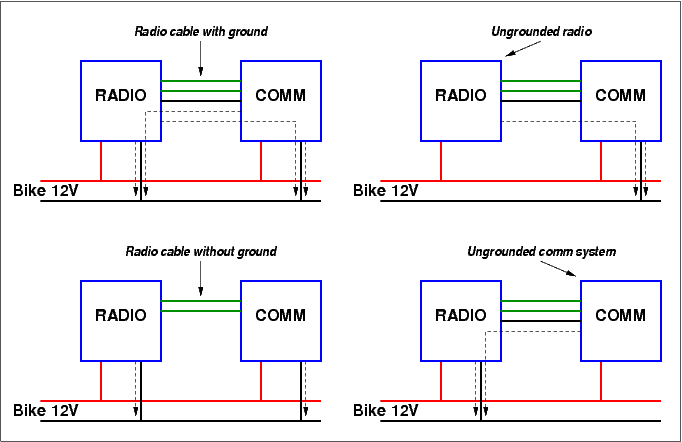You are here: STWiki>General Web>GroundLoops (05 Aug 2010, MarkFeit)Edit Attach
Ground Loops Explained
A ground loop is a phenomenon that occurs when a device has more than one path to ground. "Ground" can mean earth ground or, as in the case on motorcycles and cars, the negative terminal of the battery. Signals looking for ground will take the path of least resistance, and that path can change from moment to moment with circuit conditions. In a system that handles audio, this condition can lead to unwanted noise. This shows examples of how ground loops can form and three of the ways to eliminate them:
- Break the ground line between the radio and comm system as shown at the lower left. A signal in either device has only one way to find ground, and that's via the device's connection to the negative rail.
- Break the negative connection on one device or the other as shown on either of the diagrams on the right. Signals looking for ground will find only one way to ground, and that's through whichever device is grounded. The down side to this approach is that the current to power the ungrounded device has to be carried through the radio cable and the other device, and that usually precludes the use of anything that requires high power.
- For lines carrying AC signals such as audio, an isolation transformer can be installed. The transformer will induce the signal coming from one side onto the other with no DC connection, keeping the grounds separated.
- grounding.png:
| I | Attachment | Action | Size | Date | Who | Comment |
|---|---|---|---|---|---|---|
| |
grounding.fig | manage | 5 K | 08 May 2010 - 20:18 | MarkFeit | |
| |
grounding.png | manage | 10 K | 08 May 2010 - 15:48 | MarkFeit |
Edit | Attach | Print version | History: r3 < r2 < r1 | Backlinks | View wiki text | Edit wiki text | More topic actions
Topic revision: r3 - 05 Aug 2010, MarkFeit
 Copyright © by the contributing authors. All material on this collaboration platform is the property of the contributing authors.
Copyright © by the contributing authors. All material on this collaboration platform is the property of the contributing authors. Ideas, requests, problems regarding STWiki? Send feedback


